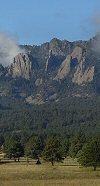 Guy Burgess
Guy BurgessNote: This post was written prior to the creation of this blog and as part of an earlier stage in the ongoing public debate over Boulder Open Space and Mountain Parks policies. While somewhat dated, the post still raises important issues which are still relevant.
It's obvious that a great deal of uncertainty exists regarding the resilience of ecosystems and the impact of various human visitation options. In the face of such uncertainty one has two basic options. One can implement an extremely cautious management plan -- one that essentially excludes visitors from an entire area. While this would obviously minimize the risks associated with human visitation, it's highly probable (but not certain) that the environmental benefits of such an approach would be quite small, at least as compared with a modest, environmentally sensitive human visitation program. Taking the most conservative approach possible would still be the obvious choice, except for the fact that there are real costs associated with unnecessary visitor restrictions. These include, for example, diminished public understanding of prairie and other ecosystems, reduced public support for open space programs, and human quality of life impacts.
It is these costs which are pressuring OSMP land managers to look for ways of simultaneously pursuing both recreational and preservation objectives. In short, they are in the politically difficult position of having to decide how cautious is too cautious.
Under such circumstances is common for the parties to wish that they knew more. Better science would reduce uncertainties in the corresponding level of needed caution. It would allow land managers allow greater visitation while simultaneously maintaining or even strengthening the level of environmental protection.
The good news is that there is a practical and inexpensive strategy for reducing uncertainty. It is based on the fundamental principle that the longer you look into the future the greater the level of uncertainty. To date the visitor planning has focused on long-term decisions with the apparent goal of crafting a series of policies which would not have to be continually reviewed. To my knowledge there was little planning and budgeting for impact monitoring and the prompt mitigation of unanticipated adverse impacts. If you're going to manage this way, you it have to have very large safety margins which, in turn, force unnecessary and controversial visitor restrictions.
An alternative, adaptive management strategy would focus more attention on short-term decisions and include funding for the continued monitoring of visitation and environmental impacts. It would have the money needed to be able to identify environmental problems as they arise and then promptly take appropriate corrective measures. It would be able to act before problems got out of hand and while mitigation options were still feasible and affordable. Similarly rewarding new visitor opportunities to be added based upon visitor suggestions and continuing environmental assessments.
For example, in areas where there are concerns that visitors might allow the seeds of invasive species to "hitchhike" on their clothing, the visitor plan could include funding a systematic search for invasive species at the earliest stages of the flowering season---when they are easily identifiable and before they've had a chance to reproduce. Any plants that are found could be destroyed and if the number of invasive plants is significantly greater than those found in the control area then a broader area closure might be implemented.
As another example, in areas where there is concern that human visitation might scare away nesting birds, the area could be closed until each year's nests are firmly established. Areas without active nests could then be reopened with the entire area opened once they the nesting season concludes. Area wide closures could then be reinstituted at the beginning of the next nesting season. An area can also be monitored for the emergence of unwanted social trails with incipient trails closed before there is significant vegetation damage









No comments:
Post a Comment